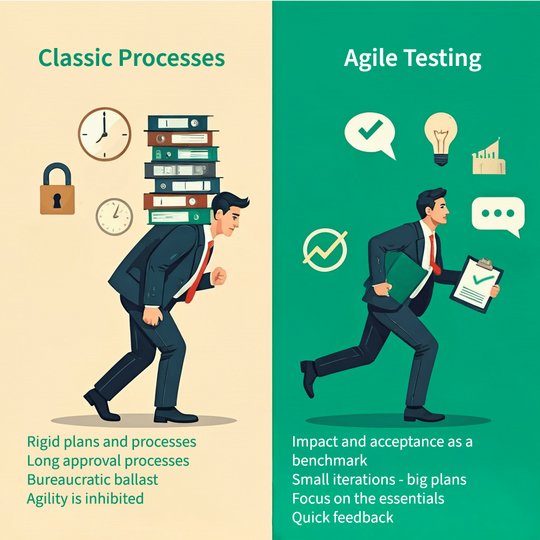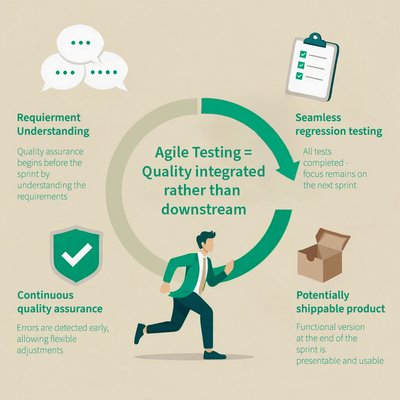Modern software development is dynamic - requirements change, features are created in short cycles, and customers expect innovative and reliable solutions. Agile testing ensures that quality is not an afterthought, but rather an integral part of the development process.
The focus is on flexibility, continuous feedback, and close collaboration:
- Early testing: Errors are detected and corrected early on, rather than accumulating until final acceptance.
- Continuous quality assurance: Tests are an integral part of the development process, not just a final or even downstream step.
- Team collaboration: Developers, testers, and specialist departments work closely together in agile testing to validate requirements early on and implement them hand in hand.
- Automation as an accelerator: Smart test automation reduces manual effort and enables fast, repeatable tests.
- Adaptability: Test scenarios adapt flexibly to new requirements – in line with agile principles.
With the right strategy and the right tools, agile testing becomes an enabler for efficiently developed, high-quality software.
Less administrative work, higher quality
Traditional, cumbersome processes and extensive documentation often lead to bureaucratic red tape that hinders agility. However, flexibility is crucial in dynamic projects: iterative approaches in agile testing reduce bureaucracy by focusing on short cycles and rapid feedback instead of getting bogged down in lengthy, downstream approval processes. Many formal protocols are eliminated through regular team coordination, and since errors are detected earlier, lengthy review loops are no longer necessary at the end.
Instead of following rigid plans, agile testing relies on lean processes, pragmatic documentation, and continuous quality assurance.
- Small iterations – big plans: Agile tests are integrated into strategic planning from the outset so that maximum quality is achieved in every development phase.
- Focus on the essentials: Only truly necessary test documents are created in order to maintain a high level of efficiency.
- Quick feedback instead of late risk: Short development and test cycles allow errors and deviations from the desired customer value to be identified in good time and corrected promptly.
- Effect and acceptance as a benchmark: Test approaches are based on the added value for users, not on rigid processes.
This adaptive approach not only reduces administrative overhead, but also improves software quality and ensures that solutions are developed that truly meet the needs of users.
Lean processes reduce administrative overhead—but what really matters is the speed with which errors are detected and corrected. This is where rapid feedback comes into play.
Fast feedback in agile testing
In agile testing, quality assurance does not begin at the end of a development cycle, but rather when the requirements are defined – even before a sprint starts. During development, changes and new features are tested in short iterations to obtain fast and accurate feedback. The goal is to deliver a “potentially shippable product” at the end of each sprint – that is, a functional state that is potentially usable from the end user's perspective and can be presented, evaluated, and ideally used (productively).
A key success factor here is the seamless execution of regression tests: only when all relevant tests have been completed at the end of the sprint can the team concentrate on the next sprint with a clear focus, without being distracted from the new context by subsequent error corrections or filling the backlog with lots of technical or functional debt.
This close integration of development and testing results in continuous quality assurance that not only detects errors at an early stage, but also enables flexible adaptation to new requirements. Agile testing thus ensures that software is improved step by step and is ready for use at any time.
Why agile testing requires automation
In order to maintain the speed and efficiency of agile development processes, all regression tests – from unit tests to integration and system tests to subject-oriented acceptance tests – should be automated as far as possible. This reduces manual effort and ensures consistently high software quality – with corresponding proof at the touch of a button. According to the DevOps motto “Automate Everything,” automation can be even more comprehensive: test data generation, on-demand provisioning of test environments, and rollback scenarios can also be automated to detect errors more quickly and minimize risks.
Would you like to reap the benefits of regression test automation while drawing on the experience of experts? We would be happy to advise you on how to use the right test automation strategy.
Do you lack the capacity to achieve meaningful coverage with automation? Take a look at our test automation services.
However, automation alone is not enough. How test activities are organized is also crucial. Instead of rigid test levels with fixed phases, agile testing focuses on flexible, continuous test activities that are dynamically integrated into development.
Test activities instead of rigid test stages
Traditional development models rely on a fixed sequence of test stages: unit, integration, and system tests. However, in short increments, there is simply not enough time for this inflexible test stage model. Instead of rigid test phases, test activities need to be parallelized, efficiently integrating various test objectives into “micro test cycles.” These cycles typically run through a sequence of automated unit, integration, and system tests within 24 hours, ensuring continuous quality.
In an agile context, test stages are no longer understood as strictly sequential phases, but as different types of tests with specific goals. The agile test quadrants provide guidance, helping to combine tests across teams in a meaningful way – from automated unit tests to exploratory tests with a customer focus. This approach directly contributes to the agile vision of moving from a requirement to a value-adding software function in the shortest possible time. Agile testing makes it possible to seamlessly integrate quality assurance into development, obtain rapid feedback, and thus continuously improve the software.
But even the best testing strategy stands or falls with the team that implements it. So what makes a perfect agile team?
T-Shape & PI-Shape
T-Shape model
The T-shape model describes people who have in-depth expertise in one area (the vertical axis of the “T”) but also have broad knowledge in related areas (the horizontal axis of the “T”).
Characteristics of a “T-Shaped Professional”:
- Specialized knowledge in one area (e.g., test automation, development, UX)
- Basic knowledge in related areas (e.g., manual testing, requirements engineering, DevOps)
- Ability to collaborate with other disciplines
Example:
A test automation engineer who has in-depth knowledge of test frameworks (e.g., Playwright, Robot Framework) but also understands the basics of software development, CI/CD, and requirements is a “T-shaped” tester.
Advantages in an agile team:
If you use the strengths of “T-shaped” teams correctly and deploy team members accordingly, you will achieve:
- Increased flexibility – team members can support each other
- Better collaboration between disciplines
- Distributed expert knowledge and thus fewer knowledge silos
π - Shape model
The π-shaped model expands on the T-shaped concept by taking two or more areas of expertise into account. This means that a person has several areas of expertise at different levels of depth instead of just one. The “X” represents a broad base (horizontal bar) with two areas of deep expertise (two vertical bars).
Characteristics of an π-shaped professional:
- Expert knowledge in two or more disciplines (e.g., test automation and software development)
- Broad understanding of other relevant disciplines (e.g., UX, DevOps, requirements)
- Greater adaptability in interdisciplinary teams
Example:
A tester who has mastered both test automation and exploratory testing at a high level is π-shaped. The same could be said of a developer who has both in-depth coding skills and strong knowledge of test strategy.
- Even more flexibility than with T-shape
- Only when more than one person is eligible for tasks does the team spirit come into play
- More efficient collaboration between developers and testers
- Reduction of dependencies within the team
Agile teamwork – working together to achieve quality
Successful agile testing requires a strong, interdisciplinary team in which all members share responsibility for quality. Testers work closely with developers from the outset, jointly formulate high-quality requirements, pair up in programming sessions, and the team often builds initial testable versions within a few days to check correctness and enable rapid feedback.
In the process, traditional role models become blurred: models such as T-shape or -shape enable team members to contribute additional skills alongside their core competencies. Testing tasks are thus not delegated solely to specialized testers, but are carried out collaboratively.
This mindset leads to close cooperation between testers, developers, and customer representatives (e.g., the product owner in Scrum). Instead of relying on extensive documentation, agile teams prefer direct communication and pair programming to efficiently create and test test cases. Quality is thus not understood as a phase at the end of the sprint, but as an integral part of the entire development process.
Shared responsibility for quality requires genuine self-organization: everyone contributes where they can make the greatest impact. The team works together to optimize requirements and acceptance criteria, testers provide feedback directly during development, and developers actively participate in testing. The result is software that is not only as error-free as possible, but also practical and valuable for the user.
Agile testing therefore means not only early and continuous feedback, but also a new form of collaboration - one that makes quality a shared mission.
Testers and developers – partners in agile testing
In traditional development processes, testers were the natural enemies of developers: while developers wrote software, testers searched for errors – and exposed them.
Agile testing has fundamentally changed this relationship. Today, everyone is in the same boat: the entire agile team is jointly responsible for the quality and success of the software. Testers are no longer downstream controllers, but partners of the developers, helping to avoid errors early on instead of just uncovering them later.
A concrete example of this collaboration is joint exploratory testing. Instead of conducting tests in isolation, agile testers prepare a script for the team that guides them through test scenarios that have not been sufficiently explored to date. All team members - developers, testers, and other specialist roles - actively participate in identifying weaknesses and evaluating the software from different perspectives.
How imbus can help you with agile testing
We are your point of contact when it comes to agile testing – take advantage of imbus' consulting services now and actively improve your testing processes and products!
We offer the following solution steps and services:
- Do you want to further qualify the members of your agile teams? Is it important to you that the quality assurance of your product is carried out using efficient and appropriate agile testing methods? The imbus Academy offers suitable training and certification programs for this purpose.
- Don't want to reinvent the wheel, but rather benefit from the years of experience of our senior consultants? We would be happy to accompany you as coaches in your agile transformation in all aspects of software quality assurance.
- Do you want to help existing system testers leave the world of waterfall behind? We coach your employees to become key enablers of the DevOps concept.
- Do many of your teams use different tools and architectures for the same purpose? Now you want to leverage the synergies of cross-functional tooling? We help your teams define and build a cross-functional architecture for test automation and select the appropriate tools. Without the automation efforts of the many agile teams being coordinated in the form of aligned continuous integration pipelines, the “shippable product” at the end of the sprint or product increment remains a pipe dream. Comprehensive, robust, and maintenance-friendly automation of regression tests prevents the continuous accumulation of technical debt.
- Experience shows that agile transitions often lead to difficult situations characterized by competing or even conflicting goals. As neutral moderators, we contribute significantly to finding solutions based on our best practices.
Do you have a “Lean-Agile Center of Excellence” but lack testing expertise? We are happy to take on the role of agile test coach.
Your contact person at imbus
Mrs. Klaudia Dussa-Zieger
mail: quality-improvement@imbus.de
phone: +49 9131 / 7518-740
fax: +49 9131 / 7518-50
![[Translate to English:] [Translate to English:]](/fileadmin/_processed_/4/5/csm_imbus.de_Softwarequalitaet_Header_0870021f2d.jpg)






